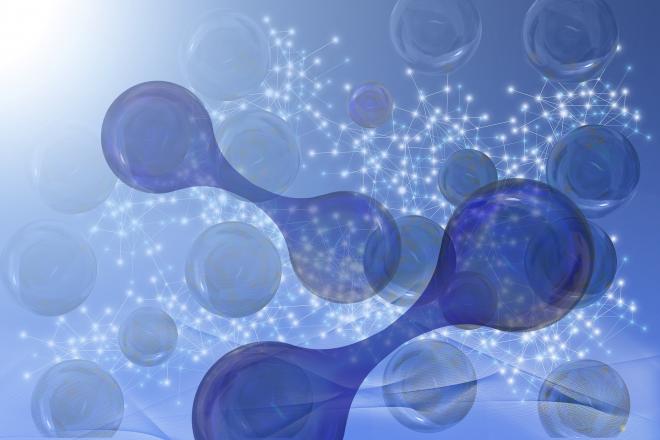HPC lowers the barrier when producing hydrogen
The Challenge:
Hydrogen production is vital to many industrial processes but relies on rare and expensive metals like platinum.The Solution:
Ciaran Ward at University of Otago used NeSI’s Māui supercomputer to model molybdenum disulfide chemistry as a hydrogen production catalyst.The Outcome:
The model showed how molybdenum disulfide can be modified to improve its catalytic ability when treated with gold and graphene. The work contributed to Ciaran Ward’s Master’s thesis and has applications in nitrogen and CO2 reduction.
Hydrogen gas is vital to processes such as fertilizer production, petroleum refining, and processing metals. It also has exciting applications in energy storage, as part of hydrogen fuel cells. In the University of Otago's Department of Chemistry, Ciaran Ward has been exploring new methods to improve hydrogen production using high-performance computing (HPC).
Commercial hydrogen production relies on platinum and other expensive metals to act as a catalyst to make the chemical reactions involved occur faster and require less energy. But platinum is extremely expensive and subject to supply shortages. Finding a cheaper alternative to existing catalysts could save money, make hydrogen production more viable, and protect New Zealand’s chemical production sovereignty.
A potential replacement for platinum is molybdenum disulfide (MoS2). This molecule is easy to produce and widely available but is a less effective catalyst for hydrogen production.
“It's probably not good enough for us to use it yet as industrially-viable chemistry. But we can relatively easily make changes to molybdenum disulfide to make it better,” says Ciaran.
He studies MoS2’s potential as a hydrogen evolution catalyst. Part of Ciaran’s research involved treating MoS2 with other compounds to increase efficiency. He used the Māui supercomputer to model how different MoS2 treatments might improve the hydrogen production.
“When you're trying to understand any reaction, you want to know about its thermodynamics and kinetics," he says. "The thermodynamics and kinetics of a reaction show us how it occurs, how fast it occurs and how much energy is required for it occur on the surface of a catalyst.”
Ciaran used the Vienna ab initio simulation package to perform dimer calculations. These calculations determine the moments of highest energy which occur when a molecule is transforming. These moments act as barriers to hydrogen conversion. By identifying them, Ciaran could fine-tune MoS2 catalysts to lower the energy barrier. But dimer calculations are notoriously computationally expensive.
“It needs HPC. Some of these dimer calculations wouldn't converge for two or three weeks.”
The limitation to any molecular model is the amount of processing power and time available. Researchers can sacrifice accuracy to lower these requirements, but this makes any results less reliable. Experimentally useful results require HPC resources like those of NeSI.
Because of the large computational requirements, Ciaran reached out to Chris Scott, a Research Software Engineer at NeSI, for a consultation. With Chris’s help, Ciaran was able to reduce calculation time by roughly 10%.
“Chris was great, I was able to give a simplified version of the calculations we've run, and he was able to troubleshoot the running of these calculations.”
“I was a little bit apprehensive because I knew I don't have this background working with high performance computers and clusters. Chris tested parallelization and found a compiler we could use.”
Ciaran discovered the Māui supercomputer would be more convenient and accessible for his project. But this meant partitioning jobs into 24-hour periods. The consultancy with Chris allowed Ciaran to plan and take advantage of the smaller run-time.
“There was a benefit to going back every day to resubmit the calculation. Each time I resubmitted I was checking the calculation.”
While MoS2 is not as efficient as platinum, it is much cheaper and more abundant. Elemental platinum currently costs roughly $100NZD per gram, while molybdenum disulfide can be produced for a fraction of this price. It would also make New Zealand’s hydrogen production more resilient to global platinum shortages.
Ciaran’s model found placing MoS2 on a surface of gold (III) and graphene can drastically change the energy barrier of MoS2 transformation (one lowers it and the other increases it), evidence that the MoS2 is tuneable. This could make it a more effective catalyst. The model could also be applied to other reactions that involve reduction chemistry.
“It could potentially be used in nitrogen reduction and carbon dioxide capture for biofuels. This method is very quick and efficient for modelling reactions, compared to other forms in literature.”
Hydrogen evolution is a major component of New Zealand’s future energy security. New Zealand has partnered with Germany for $2 million in hydrogen research. It is also part of New Zealand’s pledge to meet Paris Agreement targets and provide production sovereignty for critical resources like ammonia. Ciaran’s work provides an exciting opportunity for catalyst alternatives to meet these challenges and could not be possible without NeSI.
Do you have an example of how NeSI platforms or support advanced your research? We’re always looking for projects to feature as a case study. Get in touch by emailing support@nesi.org.nz.







